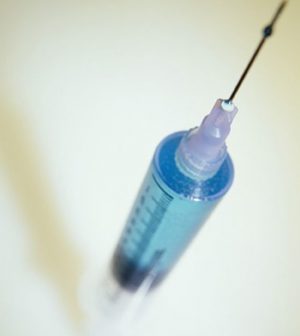- Skip Storing This Everyday Product in the Fridge Door
- Green Tea + B3 Pairing May Boost Brain Health
- Navigating Your Midlife Crisis: Embracing New Possibilities
- City Raccoons Showing Signs of Domestication
- Mapping the Exposome: Science Broadens Focus to Environmental Disease Triggers
- One Week Less on Social Media Linked to Better Mental Health
- Your Brain Changes in Stages as You Age, Study Finds
- Some Suicide Victims Show No Typical Warning Signs, Study Finds
- ByHeart Formula Faces Lawsuits After Babies Sickened With Botulism
- Switch to Vegan Diet Could Cut Your Greenhouse Gas Emissions in Half
FDA Moves to Resume Use of J&J COVID Vaccine

The U.S. Food and Drug Administration on Friday lifted the temporary pause it had placed on the Johnson & Johnson COVID-19 vaccine and said it will add a note to the shot’s labeling warning of the potential for rare blood clots.
The move came just hours after recommendations from a special panel of experts at the Centers for Disease Control and Prevention, which supported resuming use of the vaccine.
The CDC’s Advisory Committee on Immunization Practices (ACIP) determined that the benefits of the vaccine in preventing deaths and hospitalizations far outweigh the risks of rare blood clots, risks that are mainly borne by young women.
The J&J vaccine has certain advantages over the Pfizer-BioNTech and Moderna shots also approved for use in the United States, because unlike those vaccines it requires only one dose and does not require super-cold storage.
The panel vote was 10 in favor, 4 opposed and one abstention. The opposing votes favored a stronger warning for women younger than 50 that would give them the option of choosing another vaccine.
The panel’s recommendation comes more than a week after the CDC pressed “pause” on the rollout of the J&J vaccine. It now goes to CDC Director Rochelle Walensky for final approval.
Just how much do the benefits of the J&J shot outweigh its risks?
In coming to its decision, ACIP considered a risk/benefit analysis that estimates that, for every one million doses of the Johnson & Johnson vaccine administered:
- 13 cases of blood clots will occur in women 18 to 49, but at the same time 12 COVID-related deaths, 127 ICU admissions for COVID and 657 related hospitalizations will be prevented.
- 2 cases of blood clots will occur in women 50 and older, but 593 deaths, 1,292 ICU admissions and 4,794 hospitalizations will be prevented.
- 2 cases of blood clots will occur in men 18 to 49, but 11 COVID deaths, 114 ICU admissions and 601 hospitalizations will be prevented.
- No cases of blood clots will occur in men 50 and older, but 708 deaths, 1,485 ICU admissions and 5,513 hospitalizations will be prevented.
The pause in use of the one-dose vaccine came after six U.S. reports, one fatal, of a rare but severe form of blood clot tied to use of the J&J shot, all occurring in women.
At Friday’s meeting, a CDC scientist presented nine new confirmed cases of the disorder, bringing the total to 15, The New York Times reported. All the cases have been in women, and 13 have been in women between 18 and 49 years old.
Three women have died from the rare clots and seven remain hospitalized, four of whom are in the intensive care unit, the CDC scientist said.
At the time of the pause, more than 7 million doses of the J&J vaccine had been administered so far in the United States.
Dr. Joanne Waldstreicher, the chief medical officer of Johnson & Johnson, said the company has agreed with the U.S. Food and Drug Administration to add a warning label to the vaccine, which notes that “most cases” of the clotting disorder have occurred in women between 18 and 49 years old.
ACIP is calling the rare clots thrombosis with thrombocytopenia syndrome (TTS). TTS is characterized by a rare form of clot in the brain (and possibly elsewhere in the body) that occur in tandem with a low level of blood clotting cells called platelets.
According to CNN, some blood specialists believe the clots could stem from an unusual immune reaction targeting platelets, which causes the platelets to clump together to form a clot.
One of the most worrying things about the clots is that they are atypical and require different treatment. They occur in unusual places, such as in veins that drain blood from the brain, the Associated Press reported. The six cases first announced last week raised an alarm bell because that number is at least three times more than experts would have expected to see of more typical clots, said the CDC’s Dr. Tom Shimabukuro.
“What we have here is a picture of clots forming in large vessels where we have low platelets,” Shimabukuro explained to the AP. “This usually doesn’t happen,” but it is similar to European reports of clotting with the AstraZeneca vaccine.
According to CNN, Johns Hopkins University blood specialist Dr. Michael Streiff will brief the ACIP panel on treatments for TTS. Blood thinners — with the notable exception of heparin — can typically be used to dissolve the clots, and an immune product called IVIG can also help dampen the erroneous immune response.
In Europe, most but not all cases following AstraZeneca vaccinations have been among women under 60, leading different countries to deploy that vaccine in more limited ways.
More information
The U.S. Centers for Disease Control and Prevention has more about COVID-19 vaccines.
SOURCES: Advisory Committee on Immunization Practices meeting, April 23, 2021; The New York Times; CNN
Source: HealthDay
Copyright © 2025 HealthDay. All rights reserved.










